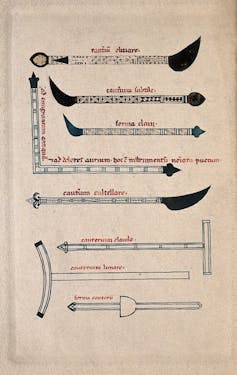Restrictions on medical care for transgender youth assume that without the ability to medically transition, trans people will vanish.
As of 2024, 26 U.S. states have banned gender-affirming care for young people. Less than a month into office, President Donald Trump issued numerous executive orders targeting transgender people, including a mandate to use “sex” instead of “gender” on passports, visas and global entry cards, as well as a ban on gender-affirming care for young people. These actions foreground the upcoming Supreme Court case of U.S. vs. Skrmetti which promises to shape the future of gender-affirming health care in the U.S., including restrictions or bans.
History, however, shows that withholding health care does not make transgender people go away. Scholarship of medieval literature and historical records reveals how transgender people transitioned even without a robust medical system – instead, they changed their clothes, name and social position.
Table of Contents
Surgery in medieval times
Surgery was not a widespread practice in the medieval period. While it gained some traction in the 1300s, surgery was limited to southern France and northern Italy. Even there, surgery was dangerous and the risk of infection high.
Cutting off fleshy bits is an old practice and, potential dangers aside, removing a penis or breasts wasn’t impossible. But amputating functioning limbs was nearly always a form of punishment. Medieval people, including surgeons and patients, likely would not have had positive views of surgery that involved removing working body parts.
Wellcome Collection
Surgeons in the 14th century were increasingly thinking about how to perform surgery on those with both male and female genitalia – people now called intersex. But they thought about this in terms of “correcting” genitalia to make it more apparently male or female – an attitude still present today. Historically, the procedure was probably performed on adults, but today it is usually performed on children. Both then and now, the surgery often disregards the patient’s wishes and is not medically necessary, at times leading to complications later. For patients deemed female, excess flesh could be cut away, and for patients deemed male, the vulva could be cauterized to close it.
There is, however, at least one historical example of a transgender individual receiving surgery. In 1300, near Bern, Switzerland, an unnamed woman was legally separated from her husband because she was unable to have sex with him. Soon after, the woman headed to Bologna, which was the surgery capital of Europe at the time. There, a surgeon cut open the woman’s vulva, revealing a penis and testicles. The account ends, “Back home, he took a wife, did rural work, and had legitimate and sufficient intercourse with his wife.”
The story presents the possibility of medical transition, possibly even a desire for it. But given the limits of surgical techniques and ideologies at the time, these forms of medical transition were unlikely to be common.
Transitioning without medicine
To transition without medicine, medieval transgender people relied on changes they could make themselves. They cut their hair, put on different clothes, changed their names, and found new places in society.
In 1388, a young woman named Catherine in Rottweil, Germany, “put on men’s clothes, declared herself to be a man, and called herself John.” John went on to marry a woman and later developed breasts. This caused some initial consternation – the city council of Rottweil sent John and his wife to court. However, the court did not see breasts as inhibiting John’s masculinity and the couple went home without facing any charges.
In 1395, a transgender woman named Eleanor Rykener appeared before a court in London, England, after she was caught working as a prostitute. The court clerk wrote “that a certain Anna … first taught [her] to practice this detestable vice in the manner of a woman. [She] further said that a certain Elizabeth Bronderer first dressed [her] in women’s clothing” and later she took on work as an embroideress and tapster, a sort of bartender. The account is Rykener’s own, but the court clerk editorialized it, notably adding the phrase “detestable vice” in reference to prostitution.
British Library Catalogue of Illuminated Manuscripts/Sloane MS 2435, f. 9v.
Rykener’s account reveals that there were a number of people interested in helping her transition – people who helped her dress, taught her how to behave, provided her employment and supported her choice of a new name. Community was a more important part of her transition than transforming her body. Based on the record, she apparently did not make an effort to create breasts.
Another account appeared in 1355 in Venice, Italy, concerning Rolandina Ronchaia. While John declared himself male, and Rykener was very active in her transition, Ronchaia’s transition was spurred on by the perceptions of others. She argued that she had always had a “feminine face, voice and gestures,” and was often mistaken for a woman. She also had breasts, “in women’s fashion.” One night, a man came to have sex with her, and Ronchaia, “wishing to connect like a woman, hid [her] own penis and took the man’s penis.” After that, she moved to Venice, where, although she continued to wear men’s clothes, she was still perceived as a woman.
Ronchaia’s account is unique because it emphasizes her body and her desire to change it by hiding her penis. But this was still a matter of what she herself could do to express her gender, rather than a medical transition.
A long transgender history
The accounts of medieval transgender individuals are limited – not only in number but in length. A lot of things did not get written down, and people were not talking about transgender people the way we are now.
Historical accounts of transgender individuals are almost always in court records, which reflect the concerns of the court more clearly than the concerns of its subjects. The court was especially worried about sexual activity between men, which both overemphasizes the importance of sex in medieval transgender people’s lives and often obscures that these accounts are even about transgender people. Eleanor Ryekener’s account frequently misgenders her and refers to her as “John.”
But it’s clear that transgender people existed in the medieval period, even when medical care was unavailable to them.
Internet Medieval Source Book/Wikimedia Commons
It is also the case that many of these individuals – Rykener is a likely exception – were probably intersex, and their experience would be different from those who were not. Intersex people were legally recognized and allowed some leeway if they chose to transition as an adult. This is starkly apparent in an account from Lille, France, in 1458, where a transgender woman was accused of sodomy and burned at the stake. She claimed “to have both sexes,” but the account says this was not the case. While being demonstrably intersex may not have saved her, that she claimed she was is telling.
Gender transition has a long history, going even further back than the medieval period. Then as now, the local community played a vital role in aiding an individual’s transition. Unlike the medieval period, most modern societies have far greater access to medical care. Despite current restrictions, transgender people have far more options for transition than they once did.
Medieval modes of transitioning are not a solution to current denials of medical care. But medieval transgender lives do illuminate that transgender people will not vanish even when the legal and medical systems strive to erase them.
























